All things Electronic
Sailing & Navigation instruments
Existing state:
Raymarine based system - 20 years old - give or take
There are 4 transducers
There is a sonar - doesn't work
Speed - clogged but was able to be removed and cleaned
Depth - Works but is sealed to hull
Temp - works but is sealed to hull
RADAR - unknown condition
Helm Chartplotter - screen is blown out, but it does power on
Autopilot - appears to function - ram was disconnected from quadrant
Wind instrument - appears to work
mostly unistalled and removed on 27 Mar
The plan
Garmin
replace w Garmin from storage
Cockpit Displays - Need to design helm station - liked having 2 MFDs in the helm station
Salon Display - Add an MFD in the salon
Garmin Network - install from storage
NMEA 2000 backbone - install from storage
Instruments - replace from storage
Transducers - DST 810 (Storage)
Wind Instruments - New (in storage)
GPS - replace from storage
Auto Pilot - need to determine way ahead - likely replace from storage
RADAR - likely replace from storage - move to solar arch?
Satellite Compass - install from storage
Rudder indicator - new
The NMEA 2000 Electronics Data Bus/ Network
This is the primary network over which most of the boat's electronics interconnect. Our network is more complex than most boats, but we are using it to control and monitor most of the systems on the boat.
Both the new main engine and the GenSet have NMEA 2000 interfaces, and that will allow us to view their data on the chart plotters and also remotely control them.
The NMEA2000 network interconnects all of the ships navigation systems (wind, depth, water speed, water temp, GPS, Compass, rate of turn, heal etc.)
The RADAR and AIS information is also shared through this network and the Garmin dedicated IP network.
Taken all together, this network is the heart of creating a common situation display and accompanying ability to centrally control the associated systems. The electrical system has its own data environment which is covered below.
Specifically the devices found on our NMEA2000 back bone:
Airmark DST810 - This is our depth, water speed and water temperature transducer. It is mounted in a through hole forward of the keel.
Garmin Wind Instrument - This instrument is found at the top of our mast. It measures wind speed and direction.
Water Maker control interface - This will allow us to remotely monitor and control the function of our watermaker
We have a number of devices from the Yacht Devices line of products:
Ethernet Bridge - allows us to see and interact with the NMEA 2000 data from mobile devices and our PCs
USB Bridge - allows us to manipulate NMEA 2000 on the PC
Run Time Indicator - This 4 channel device allows us to measure voltage or current on electrical devices wired through this device. This is how we will track the operation of the fresh water and bilge pumps
Electronic Switch control - This 4 channel device will be triggered by the Run Time Indicator to send signals to the master alarm panel to raise specific alarms there
Quark - this is our bridge for the EMTRAK A100 which is our AIS Transceiver - the Transceiver has a dedicated external GPS antenna, there is also a Serial Interface for a PC
AlbaCombi - this is our analog to digital converter. We are running our tank sender data through 4 channels here. Additionally, we are tracking the battery state of charge on our starter batteries here.
Predict Wind Data hub - this is our primary real time tracking system. It also improves our weather routing service by providing real data on the performance of our boat under sail and motoring.
12 VDC Power
Fusion Stereo - our boat stereo can also be remoted controlled via this data network
Garmin 9xx series chart plotter - this is the chart plotter in the nav station area
Anchor Drag Alarm Monitor - This is a brand new device we are creating to automatically create an anchor alarm GeoFence when activated based on the boat's swing on anchor and raise an alarm if the boat wanders outside of the fenced area. The Monitor will use an external relay to raise an alarm at the master alarm panel.
Cerbo GX - this is the bridge between the Electrical System data and the rest of the electronics on the boat
GenSet - there is a bridge to allow us to control and monitor the GenSet remotely
Main Engine - there is a bridge to allow us to Control and monitor the main engine remotely.
RACOR Vacuum Sensor - this is a dedicated sensor on the RACOR filter assembly. This sensor monitors the vacuum pressure on the engine side of the diesel filters. As the filters load up with debris, the vacuum pressure rises. We will use this to monitor the filter status.
Reactor 40 Autopilot - This is our control system for the autopilot (Rudder Feedback Sensor, Course Computer, Autopilot motor control, Electronic Compass)
Reactor Head Unit
Garmin Satellite Compass/ GPS - this is our multi access sensor that feeds the autopilot and the Predict Wind data hub.
Garmin VHF 115 - this is our salon VHF radio (Antenna on Mast Head, shared with AIS)
ICOM 410 BB - this is our cockpit based VHF Radio (Antenna on Solar Arch)
Garmin 10xx Series Chart plotters - we have 2 chart plotters in the cockpit to allow us to monitor instruments, control systems and track progress on charts as well as see RADAR data.
The Garmin Ecosystem also has an TCP/ IP network that allows the 3 chart plotters and the RADAR & Camera to talk directly. The chart plotters also provide the bridge between the Garmin Networked devices and the rest of the electronics found on the NMEA 2000 backbone. The Garmin Chart Plotters have APPs that allow us to monitor data, control systems as well as track our progress and program desired courses. These are the heart of our electronics on the boat.
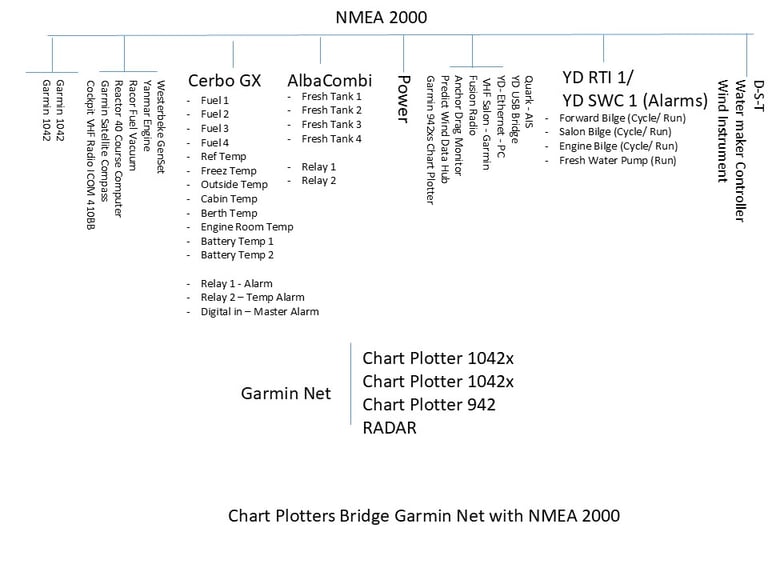

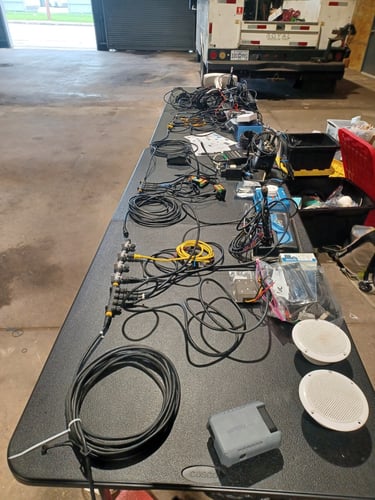

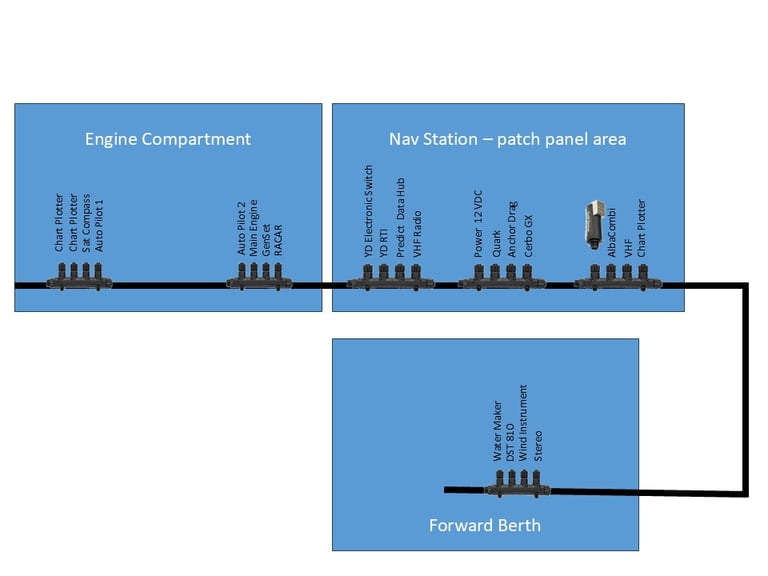

Communications
Existing State
VHF Radio - old ICOM - not NMEA 2000 compliant
SSB Radio - remove
Uninstalled 27/28 Mar
The Plan
VHF
Cockpit - ICOM 810 BB - new
Salon - Garmin 115 - new
Sell storage ICOM radios due to lack of NMEA 2000 compliance
AIS - As far as we can tell the boat doesn't have a VHF license and does not have an assigned MMSI#. We will be applying for these items so we can properly register the AIS, EPIRB and other emergency RF gear.
SatComm
Starlink - new equipment received in early Mar 2025 - this is our high bandwidth internet connectivity but it has limitations and its cost has been skyrocketing.
Iridium Go - install from storage - need antenna cable - this is our highly reliable offshore communications
InReach - Garmin Montana - replacement mount received in Mar 2025 -- this is our primary remote tracker for passages
WiFi Bridge - we can use this to piggyback on someone else's WiFi connection.
Ubiquiti Bullet - From Storage
Before Starlink, was useful to piggy back on remote wifi, not sure about usefulness today
POE
Cellular Modem - our alternative to the SatCom
Alternative to Starlink
Antenna mounted on mast
Install from storage
Ship's Router/ WiFi - this our primary LAN
ASUS xxxx
Ships IP Network
Runs the NordVPN Client on behalf of all shipboard devices communicating online
We will have CAT 5 run to the primary devices (Cerbo GX, Yacht Devices LAN bridge, Ship's PC)
We will use WiFi for our Mobile Devices and anything else that doesn't have a RJ45 port and is conveniently located within easy reach of existing LAN cabling.
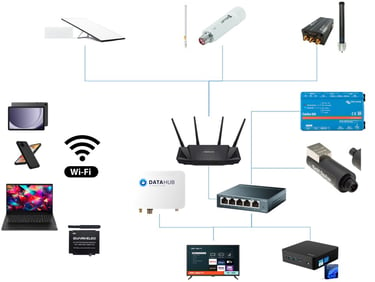

Master Alarm Panel - www.aquamarine.com
Main Engine
Water Flow - new
GenSet
Water Flow - New
Engine Room
Water In Fuel - from storage
Fire/ Heat
Smoke sensor
Electrical
Multiplus - alarm relay
Cerbo GX - master alarm
Battery Protect - Alarm out
Alternator - Alarm
Refrigeration (Cerbo GX Temp Alarm)
Pumps & Bilges
Engine Bilge (Cycling, long run time)
Engine High water alarm
Salon Bilge
Salon High Water Alarm
Fresh Water Pump (Long run time)
Dinghy
RIB Theft
Motor Theft
Electronics
Anchor Drag
AIS Alarm
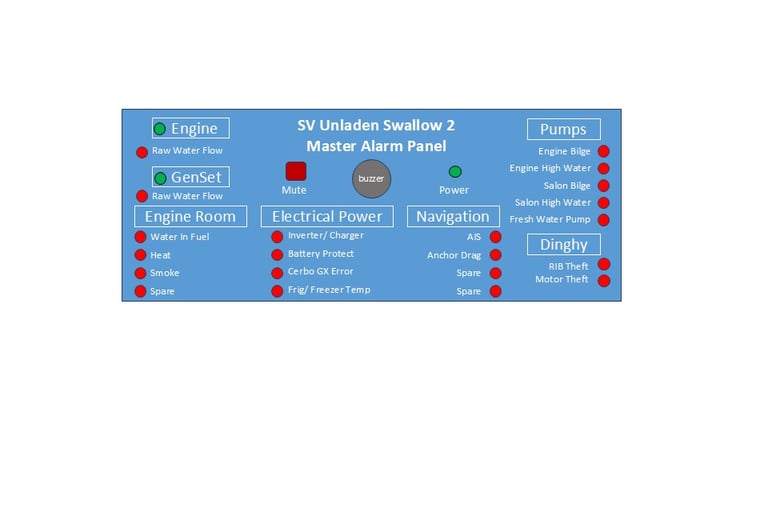

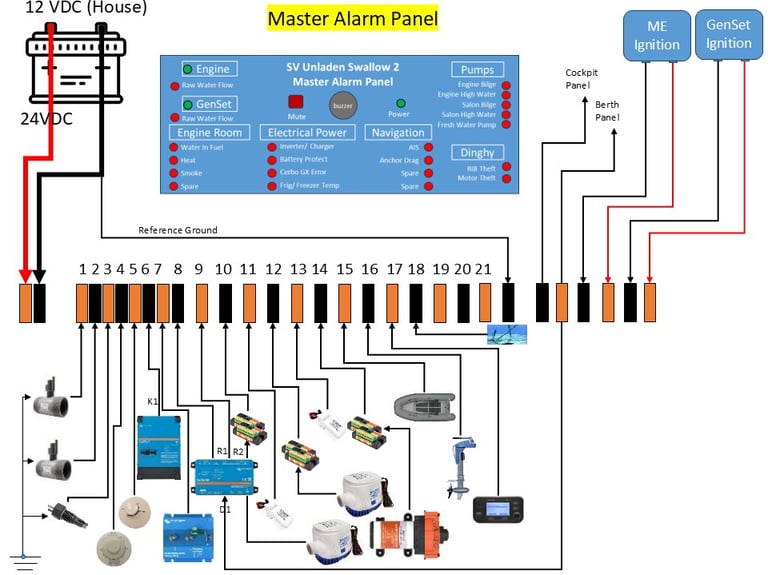

Master Alarm Panel - Explained
Most modern boats have multiple systems with audible alarms. The issue is that the standard alarm is a buzzer. Well once a buzzer goes off you have to find which one it is and then determine why it's going off. In the old boat, in its original configuration, there were at least 5 different alarms sounded the same. It drove us insane and we were determined to come up with a better mousetrap. The first iteration was based on a Yacht Devices Alarm Button. This sounded like a great idea as we could define a DIFFERENT sound for each different alarm. This turned out to be just as bad, as we still needed a cheat sheet to match which sound went with what alarm. Still too difficult to deal with when things are going sideways in a gale at 2AM in the morning.
On both Air and Space Craft they solved this problem with what's known as a master alarm panel. A single buzzer is sounded and the pilot or engineer would consult a panel that has lit buttons or lights. The button associated with the alarm is clearly lit so it's obvious which system is alarming.
The idea for the boat is simple analog panel where there is an LED light for each alarm circuit on the boat.
The various electronics devices on the boat with alarm circuits have a relay that is closed to signal an alarm state. These are directly fed into the panel.
The pumps' electrical circuits are fed through a Yacht Devices Run Time Indicator to monitor both cycle and run time. If a pump is cycling or running long, the Yacht Devices system can then close a relay sending a signal to the alarm panel. The diagram below shows how the circuits are setup to accomplish this. We will add a diagram showing the programming necessary once we complete it.
We have had issues in the past with our onboard refrigeration, so we are going to have temp sensors in the various cooled areas so that we can automatically monitor for unexpected temperature rises.
For the engine room, we are monitoring for water in the fuel system, Heat (i.e. Fire) and Smoke.
For each engine, we are monitoring raw water flow. Raw water (i.e. sea water) is crucial to keeping the engines cool. If a strainer becomes clogged or the impellors on the raw water pump fail, the cooling water flow is interrupted and the associated motor (main engine, or GenSet) will rapidly overheat and if not shut down quickly will damage itself up to and including seizing.
For the Dinghy, we are going to try a theft alarm. Dinghy (really outboard motor) theft is an issue around many islands. We can run a ground loop through these items and if the loop is cut, it will trigger an alarm on the panel.
Finally, we are working to develop an Anchor Drag alarm device that will work off of the NMEA 2000 data (GPS specifically) and sound an alarm if the boat wonders outside of a predefined area (circle with the anchor at the center of it). What is cool about our device is a combination of its simplicity, low power requirements and the external alarm. The plan is to automatically calculate the anchor position as well as the circle's allowed area. The device will alarm if the boat wonders.
We plan to have remote alarms in both the master cabin and up in the cockpit, that way we will hear an alarm at night (when the berth AC is on) or underway, for whoever is on watch up in the cockpit.
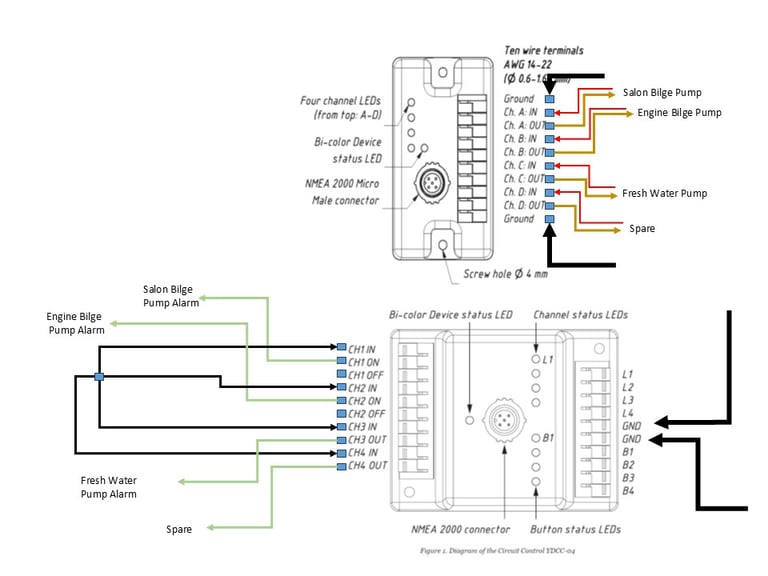

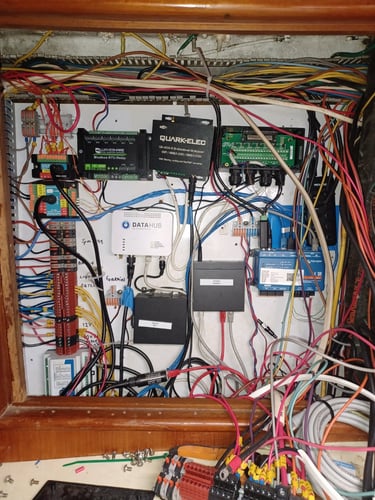


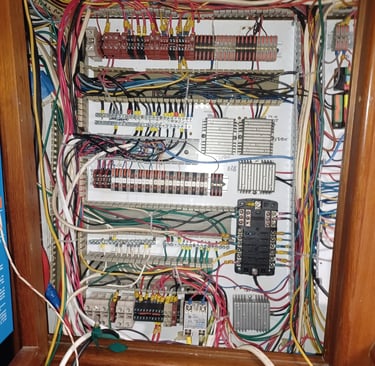
14 Jun - New Alarm Panel is onsite - may need rework as the external alarm buzzer terminals are missing
Entertainment
Existing State
TV in Salon - circa 2006
Radio in Salon
CD Changer in Salon
TV in Master Cabin
Uninstalled 27/ 28 Mar
The Plan
New Smart TV in Salon
New Smart TV in Berth
Plex - install from storage
Pulsar equipped Android Cell phone for music source
Stereo - Garmin Fusion stereo - install from storage
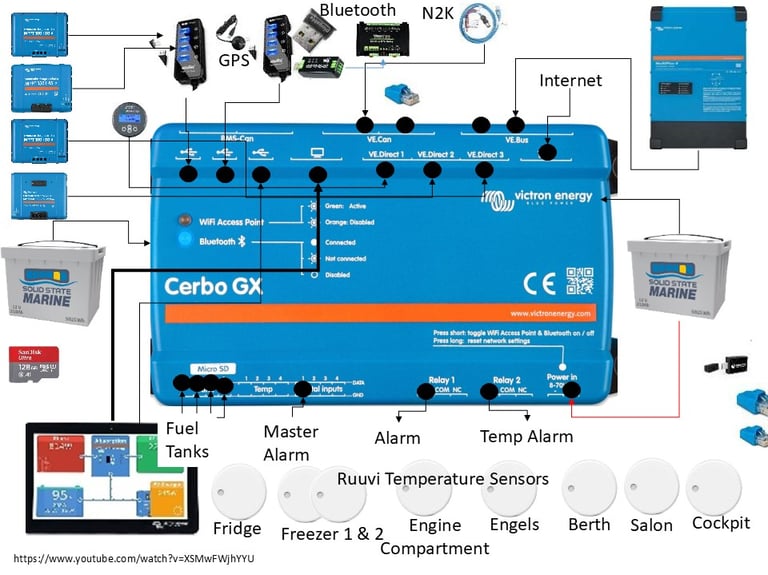

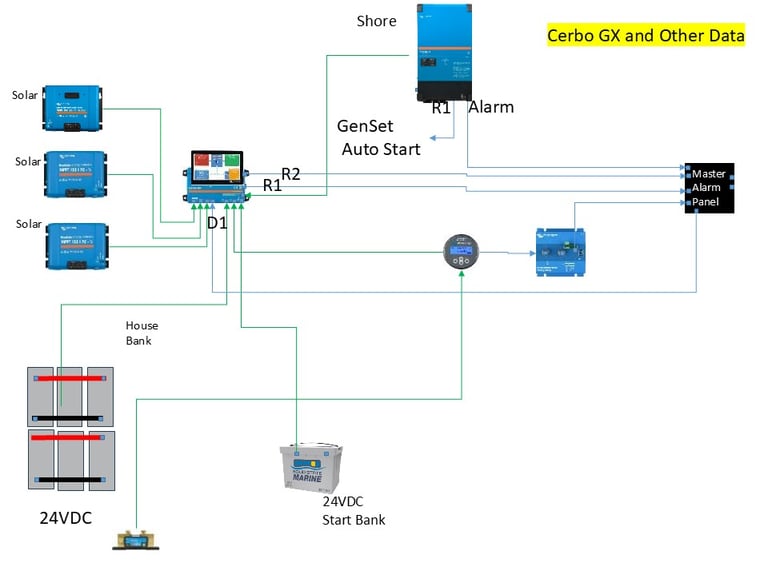

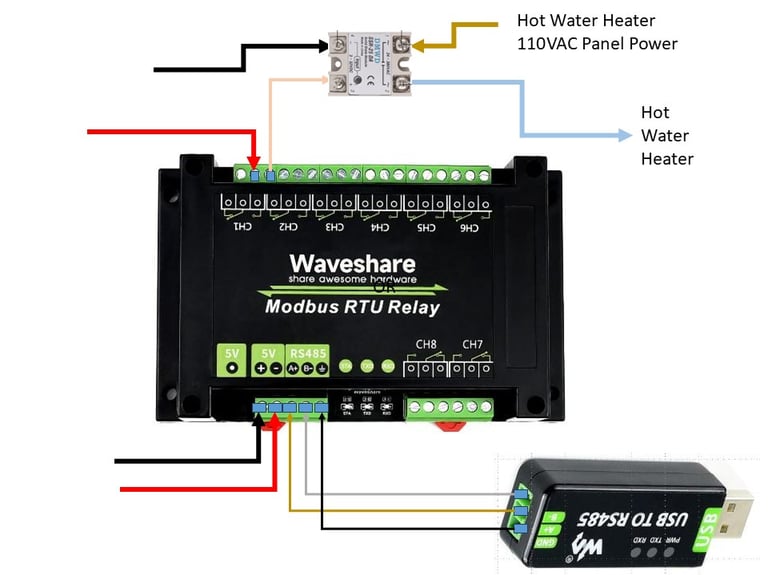

Cerbo GX and Victron's Data Environment
Victron has its own proprietary data environment to communicate between its devices.
The heart of their environment is a GX device running the Venus OS. Fun fact, the Cerbo GX is really just a raspberry pi but with a whole host of input and output ports.
The Cerbo GX has an HDMI interface to allow the use of a touchscreen monitor as the display.
The Picture above shows all of the inputs and outputs we are expecting to implement, while the green lined diagram to the upper right shows the external Victron devices connected to the Cerbo GX
Victron has a cloud environment that allows remote monitoring provided there is an internet link available. We have used this in the past quite successfully to do monitoring from anywhere as long as the boat's TCP/IP network is connected to the Internet. It also has long term data storage allowing trend analysis.
Finally, if this was all not enough, we plan to be able to turn our hot water heater on and off by a combination of the battery state of charge and the solar input. This requires some specialized programing via a system called Node Red and external relays. The picture to the right shows the devices we plan to use for this function. This is an experiment and we will post the implementation details here once we have it all working.


